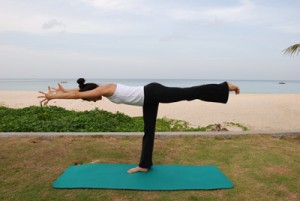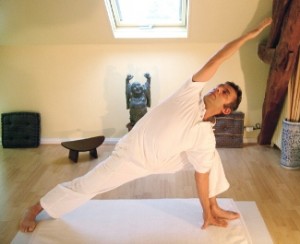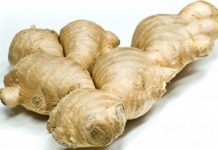Varicose veins are the large, blue, gnarled veins that usually appear on the lower legs. Although they are usually associated with middle-aged women, anyone can get varicose veins at any age. Varicose veins occur when the blood in your legs has difficulty flowing back to the heart. Age and pregnancy are considered the most common causes of varicose veins, but they can also be caused by heredity and overly tight leg muscles. Varicose veins are most often treated with compression garments to encourage blood flow, medical procedures that either close off or remove the affected vein. Patients might also be prescribed medications to thin the blood and prevent it from collecting in the lower leg.
There are also yoga poses that can help relieve the leg heaviness, swelling, and pain associated with varicose veins, as well as reduce their appearance.
Before You Begin
Although yoga is considered a gentle practice, it’s still considered exercise and, as such, you should consult your physician before you start using yoga to treat your varicose veins. You should also consult your physician if you are already under treatment for your varicose veins.
You can use these exercises in combination with natural oils and other remedies formulated for getting rid of varicose veins.
Exercises for Varicose Veins
All of these exercises are designed to encourage blood flow to your heart, and away from your lower extremities.

Viparita Karani
Viparita karani is also called “legs up the wall” pose.
· Sit with your back against the wall, or your headboard, your legs should extend straight in front of you. You can have a pillow or a folded blanket under your hips, or lie flat on the floor.
· Slowly lie down on your right side and hug your knees to your chest.
· Pivot your body so that you can roll onto your back with your hips against the wall. Raise your feet toward the ceiling and let your heels rest on the wall.
· If desired, put a pillow under your head, or a bolster under your lower back, as you lie with your feet up the wall for at least ten minutes.
· To deepen the stretch, allow your heels to drift toward the floor, opening your legs into a deep “V.”
· To come out of the pose, bring your knees back to your chest, roll over onto your side, then pivot around so that your back is against the wall and push yourself back up to seated.

Pada Sanchalanasana
Pada Sanchalanasana is also called “bicycle pose.”
· Lie flat on your back on a yoga mat on the floor, or on a firm bed, with your legs extended.
· Draw your left knee up to your chest, then press the heel of your left foot toward the ceiling, or as high as it will go, until your leg is fully extended.
· Hold and count to five
· Keep your left leg still extended and bring your left heel back to the floor, and your together.
· Draw your right knee up to your chest, and then press the heel of your right food toward the ceiling until your leg is fully extended.
· Hold and count to five
· With your right leg still extended, bring your right heel back to the floor and your feet together.
· Repeat three times on each side.
· To deepen the stretch, let the baby toe of each leg fall toward the floor while the leg is extended.
· Hold for a count of five, and then bring your heel back up toward the ceiling.
· To come out of the pose, draw both knees up to your chest, and then roll over onto your side and push yourself up.












